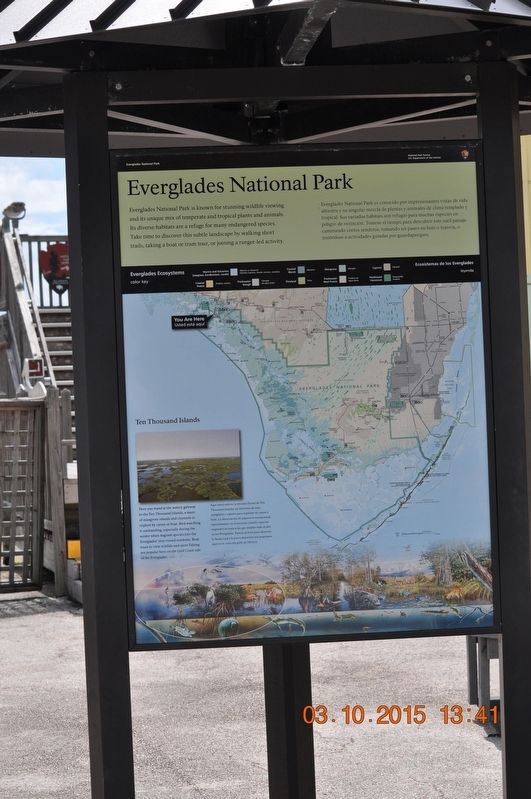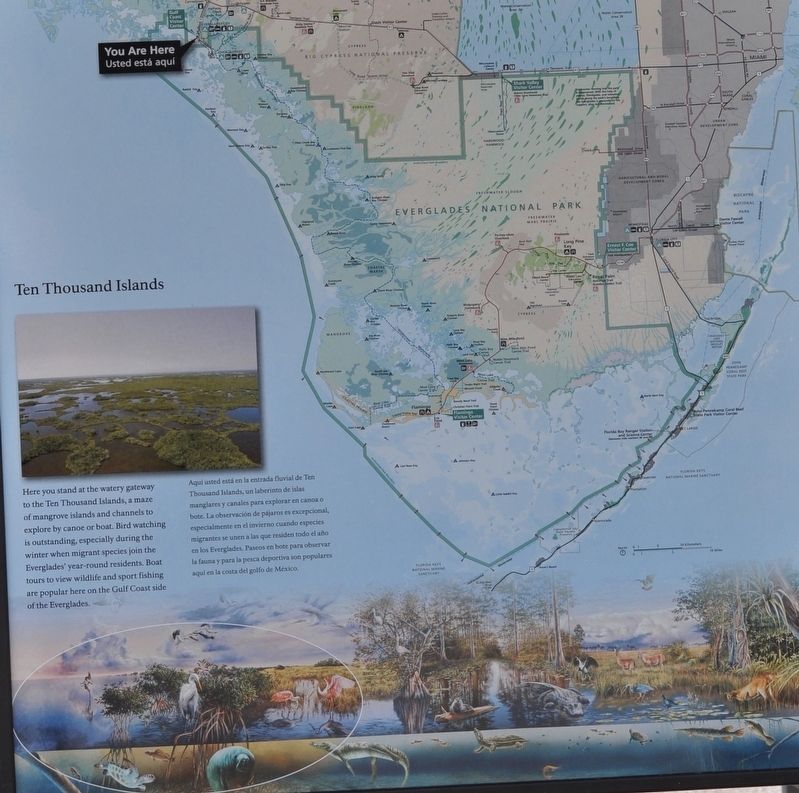Everglade City in Collier County, Florida — The American South (South Atlantic)
Everglades National Park
Everglades National Park is known for stunning wildlife viewing and it unique mix of temperature and topical plants and animals. Its diverse habitat are a refuge for many endangered species. Take time to discover this subtle landscape by walking short trails, taking a boat or tram tour, or joining a ranger-led activity.
Ten Thousand Island
Here you stand at the watery gateway to the Ten Thousand Islands, a maze of mangrove islands and a channel to explore by canoe or boat. Bird watching is outstanding, especially during the winter migrant species join the Everglades’ year-round residents. Boat tours to view wildlife and sport fishing are popular here on the Gulf Coast side of the Everglades.
Everglades Ecosystems
Color key
• Marine and Estuarine (seagrass, hard-bottom, corals)
• Costal Marsh
• Mangrove
• Cypress
• Coastal Prairie
• Freshwater Slough
• Pineland
• Freshwater Mari Prairie
• Hardwood Hammock
Erected by Everglade Park Service U. S. Department of the Interior.
Topics. This historical marker is listed in these topic lists: Animals • Entertainment • Environment.
Location. 25° 50.71′ N, 81° 23.186′ W. Marker is in Everglade City, Florida, in Collier County. Marker is on Oyster Bar Lane. Marker is located at Visitor Center. Touch for map. Marker is at or near this postal address: 815 Oyster Bar Lane, Everglades City FL 34139, United States of America. Touch for directions.
Other nearby markers. At least 8 other markers are within walking distance of this marker. Welcome To the Gulf Coast Visitor Center (here, next to this marker); Everglades Community Church (approx. 0.8 miles away); Old Laundry Building - Everglades Women's Club (approx. 0.8 miles away); Broadway (approx. 0.9 miles away); Barron G. Collier (approx. 0.9 miles away); Bank of Everglades Building (approx. 0.9 miles away); Hurricane Wilma (approx. 0.9 miles away); Old Collier County Courthouse (approx. 0.9 miles away).
Also see . . .
1. Freshwater Marshes. Marsh wildlife: Common invertebrates in this detrital ecosystem are true flies including midges, mosquitoes, and crane flies. Nematodes and enchytraceids are important decomposers in the system. Dominant mammal species include herbivores such as muskrats, shrews and mice. Waterfowl are distributed throughout the ecosystem along an elevation gradient, according to water adaptations. Abundant species include ducks, geese, swans, songbirds, swallows and black ducks. Although the shallow marshes do not support many fish, deeper marshes are home to many species,
including northern pike and carp. (Submitted on July 28, 2017, by Sandra Hughes Tidwell of Killen, Alabama, USA.)
2. Ecosystems: Cypress. Common throughout the southeastern United States, the cypress tree (Taxodium spp.) is a deciduous conifer that can survive in standing water. In the Florida Everglades these trees are often found growing in one of three distinct formations. Where the limestone substrate has given way to circular solution holes, it is common to find a cluster of cypress trees growing in the shape of a dome, with larger trees in the middle and smaller trees all around. Cypress strands occur where the cypress trees grow in an elongate, linear shape, parallel with the flow of water. In areas of less-favorable growing conditions, stunted cypress trees, called dwarf cypress, grow thinly distributed in poor soil on drier land. (Submitted on July 28, 2017, by Sandra Hughes Tidwell of Killen, Alabama, USA.)
3. Coastal Prairie Trail. Please note that the Coastal Prairie Trail is not currently being maintained because of potential damage to critical habitat in the area for the Cape Sable thoroughwort. This is a small herb in the sunflower family with bluish-purple flowers. Global distribution restricted to coastal ENP and a few sites in the Florida Keys. Park staff are reviewing trail management techniques to develop strategies that won't affect this habitat so that we can reinstate trail management in the future. For now the trail remains open but you should be aware of terrain that should be traversed carefully and may have vegetation, branches, or other flora and fauna that could affect your hike. (Submitted on July 28, 2017, by Sandra Hughes Tidwell of Killen, Alabama, USA.)
4. Ecosystems: Freshwater Slough. A slough is a low-lying area of land that channels water through the Everglades. These marshy rivers are relatively deep and remain flooded almost year-round. Though they are the main avenue of waterflow, the current remains leisurely, moving about 100 feet (30 meters) per day. (Submitted on July 28, 2017, by Sandra Hughes Tidwell of Killen, Alabama, USA.)
5. Ecosystems: Pinelands. Otherwise known as pine rocklands, these forests often take root in the exposed limestone substrate of south Florida. Though the rugged terrain is canopied almost entirely by slash pine (Pinus elliottii var. densa), the understory boasts an amazingly diverse assemblage of flora, including numerous endemic species that grow only in the local area. (Submitted on July 28, 2017, by Sandra Hughes Tidwell of Killen, Alabama, USA.)
6. Ecosystems: Freshwater Marl Prairie. Large areas of freshwater marl prairie border the deeper sloughs of the Everglades. These relatively short-hydroperiod marshes are typified by a diverse assemblage of low-growing vegetation. A complex mixture of algae, bacteria, microbes, and detritus that is attached to submerged surfaces, periphyton serves as an important food source for invertebrates, tadpoles, and some fish. (Submitted on July 28, 2017, by Sandra Hughes Tidwell of Killen, Alabama, USA.)
7. Ecosystems: Hardwood Hammock. A hardwood hammock is a dense stand of broad-leafed trees that grow on a natural rise of only a few inches in elevation. Hammocks can be found nestled in most all other Everglades ecosystems. In the deeper sloughs and marshes, the seasonal flow of water helps give these hammocks a distinct aerial teardrop shape. (Submitted on July 28, 2017, by Sandra Hughes Tidwell of Killen, Alabama, USA.)
8. Ecosystems: Mangrove. Mangrove forests are present in the coastal channels and winding rivers around the tip of south Florida. The term "mangrove" does not signify a particular botanical relation, but rather is used to identify several species of salt-tolerant trees that thrive amidst the harsh growing conditions of the coast. (Submitted on July 28, 2017, by Sandra Hughes Tidwell of Killen, Alabama, USA.)
Credits. This page was last revised on July 29, 2023. It was originally submitted on July 28, 2017, by Sandra Hughes Tidwell of Killen, Alabama, USA. This page has been viewed 313 times since then and 18 times this year. Photos: 1, 2. submitted on July 28, 2017, by Sandra Hughes Tidwell of Killen, Alabama, USA. • Bill Pfingsten was the editor who published this page.
Editor’s want-list for this marker. A wide shot of the marker and its surroundings in context. • Can you help?

